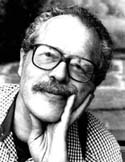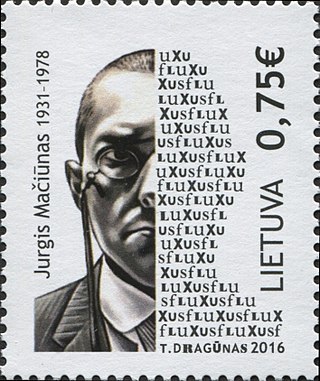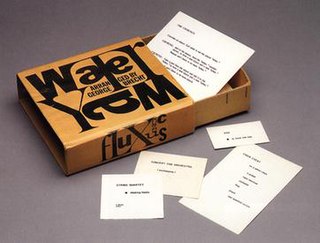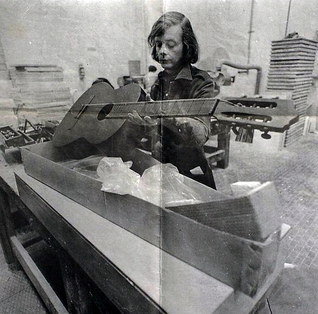Related Research Articles

Fluxus was an international, interdisciplinary community of artists, composers, designers and poets during the 1960s and 1970s who engaged in experimental art performances which emphasized the artistic process over the finished product. Fluxus is known for experimental contributions to different artistic media and disciplines and for generating new art forms. These art forms include intermedia, a term coined by Fluxus artist Dick Higgins; conceptual art, first developed by Henry Flynt, an artist contentiously associated with Fluxus; and video art, first pioneered by Nam June Paik and Wolf Vostell. Dutch gallerist and art critic Harry Ruhé describes Fluxus as "the most radical and experimental art movement of the sixties".

Dick Higgins was an American artist, composer, art theorist, poet, publisher, printmaker, and a co-founder of the Fluxus international artistic movement. Inspired by John Cage, Higgins was an early pioneer of electronic correspondence. Higgins coined the word intermedia to describe his artistic activities, defining it in a 1965 essay by the same name, published in the first number of the Something Else Newsletter. His most notable audio contributions include Danger Music scores and the Intermedia concept to describe the ineffable inter-disciplinary activities that became prevalent in the 1960s.
Intermedia is an art theory term coined in the mid-1960s by Fluxus artist Dick Higgins to describe the strategies of interdisciplinarity that occur within artworks existing between artistic genres. It was also used by John Brockman to refer to works in expanded cinema that were associated with Jonas Mekas' Film-Makers’ Cinematheque. Gene Youngblood also described intermedia, beginning in his Intermedia column for the Los Angeles Free Press beginning in 1967 as a part of a global network of multiple media that was expanding consciousness. Youngblood gathered and expanded upon intermedia ideas from this series of columns in his 1970 book Expanded Cinema, with an introduction by Buckminster Fuller. Over the years, intermedia has been used almost interchangeably with multi-media and more recently with the categories of digital media, technoetics, electronic media and post-conceptualism.
Visual poetry is a style of poetry that incorporates graphic and visual design elements to convey its meaning. This style combines visual art and written expression to create new ways of presenting and interpreting poetry.

Daniel Spoerri is a Swiss artist and writer born in Romania. Spoerri is best known for his "snare-pictures," a type of assemblage or object art, in which he captures a group of objects, such as the remains of meals eaten by individuals, including the plates, silverware and glasses, all of which are fixed to the table or board, which is then displayed on a wall. He also is widely acclaimed for his book, Topographie Anécdotée* du Hasard, a literary analog to his snare-pictures, in which he mapped all the objects located on his table at a particular moment, describing each with his personal recollections evoked by the object.

George Maciunas was a Lithuanian American artist, born in Kaunas. A founding member and the central coordinator of Fluxus, an international community of artists, architects, composers, and designers, he is most famous for organising and performing early happenings and for assembling a series of highly influential artists' multiples.

Neo-Dada was a movement with audio, visual and literary manifestations that had similarities in method or intent with earlier Dada artwork. It sought to close the gap between art and daily life, and was a combination of playfulness, iconoclasm, and appropriation. In the United States the term was popularized by Barbara Rose in the 1960s and refers primarily, although not exclusively, to work created in that and the preceding decade. There was also an international dimension to the movement, particularly in Japan and in Europe, serving as the foundation of Fluxus, Pop Art and Nouveau réalisme.

Alison Knowles is an American visual artist known for her installations, performances, soundworks, and publications. Knowles was a founding member of the Fluxus movement, an international network of artists who aspired to merge different artistic media and disciplines. Criteria that have come to distinguish her work as an artist are the arena of performance, the indeterminacy of her event scores resulting in the deauthorization of the work, and the element of tactile participation. She graduated from Pratt Institute in New York with an honors degree in fine art. In May 2015, she was awarded an honorary doctorate degree by Pratt.

George Brecht, born George Ellis MacDiarmid, was an American conceptual artist and avant-garde composer, as well as a professional chemist who worked as a consultant for companies including Pfizer, Johnson & Johnson, and Mobil Oil. He was a key member of, and influence on, Fluxus, the international group of avant-garde artists centred on George Maciunas, having been involved with the group from the first performances in Wiesbaden 1962 until Maciunas' death in 1978.

Dieter Roth was a Swiss artist who gained recognition for his diverse body of work, which included artist's books, editioned prints, sculpture, and creations from found materials, including rotting food stuffs. He was also known as Dieter Rot and Diter Rot.
Emmett Williams was an American poet and visual artist. He was married to British visual artist Ann Noël.

Hannah B. Higgins is an American writer and academic living in Chicago, Illinois. Higgins's research examines various post-conceptual art historical subjects in terms of two philosophically and practically entwined terms: information and sensation. She is a Professor in the Department of Art History and a founding Director of IDEAS, an interdisciplinary arts major, at the University of Illinois at Chicago.
Danger music is an experimental form of avant-garde 20th and 21st century music and performance art. It is based on the concept that some pieces of music can or will harm either the listener or the performer, understanding that the piece in question may or may not be performed. Kyle Gann describes in his book Music Downtown: Writings from the Village Voice how Takehisa Kosugi's composition Music for a Revolution directs the performer to "[s]coop out one of your eyes 5 years from now and do the same with the other eye 5 years later". Works such as this are also sometimes referred to as anti-music because they seem to rebel against the concept of music itself. Danger music is often closely associated with the Fluxus school of composition, especially the work of Dick Higgins who composed a series of works entitled Danger Music.

Robin Page was a British painter. He was one of the early members of the Fluxus art movement.

Water Yam is an artist's book by the American artist George Brecht. Originally published in Germany, June 1963 in a box designed by George Maciunas and typeset by Tomas Schmit, it has been re-published in various countries several times since. It is now considered one of the most influential artworks released by Fluxus, the internationalist avant-garde art movement active predominantly in the 1960s and '70s. The box, sometimes referred to as a Fluxbox or Fluxkit, contains a large number of small printed cards, containing instructions known as event-scores, or fluxscores. Typically open-ended, these scores, whether performed in public, private or left to the imagination, leave a lot of space for chance and indeterminancy, forcing a large degree of interpretation upon the performers and audience.
In some cases [event-scores] would arise out of the creation of the object, while in others the object was discovered and Brecht subsequently wrote a score for it, thus highlighting the relationship between language and perception. Or, in the words of the artist, "ensuring that the details of everyday life, the random constellations of objects that surround us, stop going unnoticed." The event-score was as much a critique of conventional artistic representation as it was a gesture of firm resistance against individual alienation.

Joe Jones (1934–1993) was an American avant-garde musician associated with Fluxus, especially known for his creation of rhythmic music machines.
Eric Andersen is a Danish artist associated with the Fluxus art movement. He lives in Copenhagen, Denmark.
Laurence Whitfield is an English artist. He was a member of The Peterloo Group, and studied at Manchester Regional College of Art, now known as Manchester College of Arts and Technology (MANCAT).

The Museo Vostell Malpartida in the Spanish village Malpartida de Cáceres west of the provincial capital Cáceres in the Autonomous Community of Extremadura is dedicated to the work of the German painter, sculptor, Fluxus and Happening artist Wolf Vostell. The museum is under the artistic direction of Mercedes Vostell and under the general direction of José Antonio Agúndez García. The Museo Vostell Malpartida was founded by Wolf Vostell and Mercedes Vostell in 1976.

Ann Noël is a British artist associated with the Fluxus movement. Noël has lived and worked in Berlin since 1980 and was married to the American artist and poet Emmett Williams. Noël's artistic practice integrates performance, installation, painting, graphic design, printmaking, and photography.
References
- Higgins, Dick (1966). "Intermedia". Something Else Newsletter. Something Else Press.
- Ruhé, Harry (1979). Fluxus: The Most Radical and Experimental Art Movement of the Sixties. Leidsekruisstraat 10, Amsterdam.
{{cite book}}:|work=ignored (help)CS1 maint: date and year (link) CS1 maint: location (link) CS1 maint: location missing publisher (link) - Frank, Peter (1983). Something Else Press: an annotated bibliography. [New Paltz, NY]: McPherson. ISBN 0-914232-40-1. OCLC 9155222.
- Higgins, Hannah (December 12, 2002). Fluxus Experience. Berkeley, California: University of California Press. p. 127. ISBN 978-0-520-22867-2 . Retrieved April 2, 2009.
{{cite book}}: CS1 maint: date and year (link) - Williams, Emmett, ed. (February 28, 2014). An Anthology of Concrete Poetry. Primary Information. ISBN 978-0-9851364-3-7.
- Higgins, Dick (November 2018). Clay, Steve; Friedman, Friedman (eds.). Intermedia, Fluxus and the Something Else Press: Selected Writings by Dick Higgins. Catskill, New York: Siglio Press. ISBN 978-1-938221-20-0.